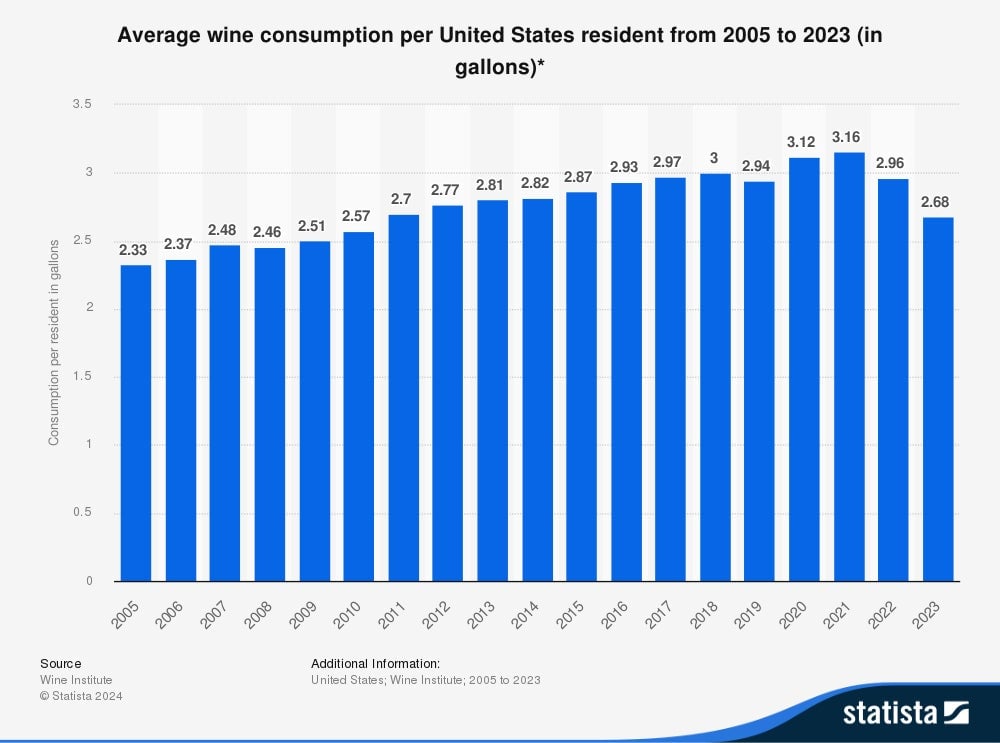The Trump tariffs are coming for wine. American restaurants could die
Finer dining restaurants make their money on the wine and alcohol they sell, not on the food

Is Donald Trump about to pull the plug on the U.S. food and wine industry? If his plan for 10% to 20% tariffs on all imported goods goes into effect, wine tariffs are likely to devastate the middle- and upper-ends of the restaurant business, while doing nothing to help U.S. producers.
Suggested Reading
That’s because finer dining restaurants make their money on the wine and alcohol they sell, not on the food. Most restaurateurs make 50% to 60% of their profit on wine and drinks, and a 10% or 20% tariff multiplies along the supply chain, often raising prices above what a customer is prepared to pay.
Related Content
“Restaurants are run at ridiculously low margins, like 3% on average, and when one of our better profit-making products is taken off the table, I don’t know where we’ll make it up,” said DeWayne Schaaf, chef and owner of Celebrations, a fine dining restaurant in Cape Girardeau, Missouri.
“A lot of people are going to have to pivot: lose wine, lose staff or close days,” he added.
Schaaf and America’s other restaurateurs and wine merchants have experience with the detrimental effect of wine tariffs. When the first Trump administration put tariffs on European wines in 2019, the duties reached 25% and were part of a WTO-sanctioned slap-back for Europe’s subsidies to Airbus airliners. Even Boeing, the U.S. firm that claimed harm from the tariffs didn’t want wines hit. The Biden Administration rescinded the tariffs in 2021.
“The ultimate goal here is to change behavior,” said Ben Aneff, an owner of a Manhattan wine store called Tribeca Wine Merchants, and president of the U.S. Wine Trade Alliance, a lobbying group for the wine business. But when the culprits in U.S. eyes are airplane builders, and European lawmakers are voting to tax U.S. tech firms to favor European tech firms, it makes no sense to slap tariffs on wine.
“Any of those companies could be tariffed as part of this,” Aneff said. “Putting tariffs on imported wine is actually the least effective way to implement behavior change overseas. Not only that, tariffs on imported wine do disproportionate damage to U.S. businesses.”
‘You’ll end up with only major wine brands’
Cutting imports of U.S. wine has a knock-on effect that may not bother the Trump administration, but that is likely to upset wine drinkers in the U.S. and abroad.
“The smaller independent producers, the diversity that the smaller guys bring to the wine market, is going to disappear, and you’ll end up with only major wine brands,” said Eric Foret, a former importer who now buys wine for a wine bar chain in the U.S. and owns Le French Wine Shop in Manhattan.
Tariffs on European wine imports are a particularly poor remedy for trade tricks because, according to several studies, U.S. businesses make more money overall on the wine trade than European companies do. And that’s because the U.S. has a strange and archaic way of selling wine.
It’s known as the three-tier system. A product of both Prohibition and states’ rights, it’s ended up as a means to extract profits and therefore taxes at every level. And it means that a U.S. restaurant or wine shop can’t buy wine directly from a chateau in the Loire Valley. Instead, a U.S. importer buys from the French winemaker and pays duty on the wine when it comes into the U.S. The wine is then sold to a distributor (effectively a wholesaler with a particular kind of license, which varies by state), who in turn sells the wine to a retailer or restaurant — which only then sells it to a consumer or pulls the cork and pours it. And each of these players marks up the price. In fact, for every dollar that goes back to France for a bottle of wine, more than $4.50 is generated in the U.S. economy.
But all that is endangered when the tariffs kick in. A bottle of wine that costs a restaurant $16 before tariffs is suddenly a $19 bottle. And once restaurants mark up the bottle to account for their costs and profits, the wine list prices can breach a psychological barrier.
“So you’re going to go from $48 to $57 if you’re selling it at three times cost,” said Bret Csencsitz, who owned the recently shuttered Gotham restaurant in New York City and is now beverage manager at a Manhattan luxury hotel. “The consumer, in that $35 to $45 mark, is like, ‘OK, that’s an easy decision.’ But over $50 in a neighborhood restaurant, the bottle starts to be a little more of a commitment.”
How much is too much?
“Anything we’re selling in the restaurant, there’s perceived value, whether it’s the cost of a tasting menu, the cost of a piece of halibut, or the cost of a bottle of wine, that people will buy it for,” said Andrew Fortgang, who owns three restaurants in Portland, including Le Pigeon and Canard. But, he warns, “Once you’ve crossed that threshold, they’ll just skip purchasing the item, and it doesn’t mean they’ll just buy the next lowest-priced thing.” And that, he said, is what really hurts. “When we lose those wine sales,” Fortgang said, “that’s a huge profit driver, and there’s nowhere else to recoup that.”
That leaves restaurant owners with a dilemma: They can’t cut back on rent, or gas, and they certainly can’t buy lower-quality food. “Then the question is, can we afford fewer employees?” Fortgang said.
With 12.4 million people working in the restaurant industry, according to the Bureau of Labor Statistics, earning an average wage of $20 an hour for an average work week of 25 hours, the restaurant industry is a huge piece of the U.S. economy. So laying off restaurant workers means less money being spent in the overall economy, less economic growth, and more people lining up for unemployment benefits.
Tariffs are often meant to protect domestic industries, but that doesn’t work with wine. First off, tastes just don’t change that quickly: You can’t change your wine list overnight and then, six months later when the tariffs fall, change it back, Schaaf said. Besides, he noted, “American wines are more expensive typically.”
Michael Kaiser, the chief lobbyist for Wine America, the trade group representing U.S. wineries, agreed that the tariffs won’t help the industry at home.
“If we place a tariff on their products, they’ll do it to us,” he said. Fine U.S. wines tend to be more expensive than their European counterparts, and the U.S. industry simply doesn’t have the capacity to replace the volume of wine produced in Europe. In fact, he said, tariffs are more likely to harm U.S. winemakers than help them. U.S. winemakers rely on the same small distributors that sell imported wine (they get to skip the importing part of the three-tier system). But if those distributors have spent their cash paying tariffs or filling their warehouses, they’ve got less cash to spend buying wines that are new to their own customers.

And the tariffs come at a particularly poor time for the American wine industry. Wine consumption had been increasing in the U.S. until recently, peaking at 3.16 gallons per person in 2021. But by 2023, per capita consumption had dropped 15% to 2.68 gallons, according to data from the U.S. Wine Institute.
Some U.S. importers are already increasing purchases from Europe in anticipation of the tariffs, Foret said. Distributors he works with tell him their warehouses are full, and many restaurants he works with have filled their cellars, anticipating the disruption and expense of Trump wine tariffs.
“A lot of the smaller importers and distributors are going to go out of business,” said Foret, who himself left the import business after the initial Trump tariffs took hold. He said he spent too much time buried in spreadsheets calculating how to keep making a profit while setting prices that would keep his customers buying wines: “They are going to give up because it’s not worth them going through four years of hassle and not making money.”
